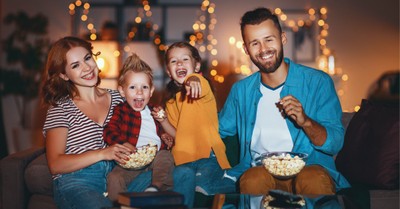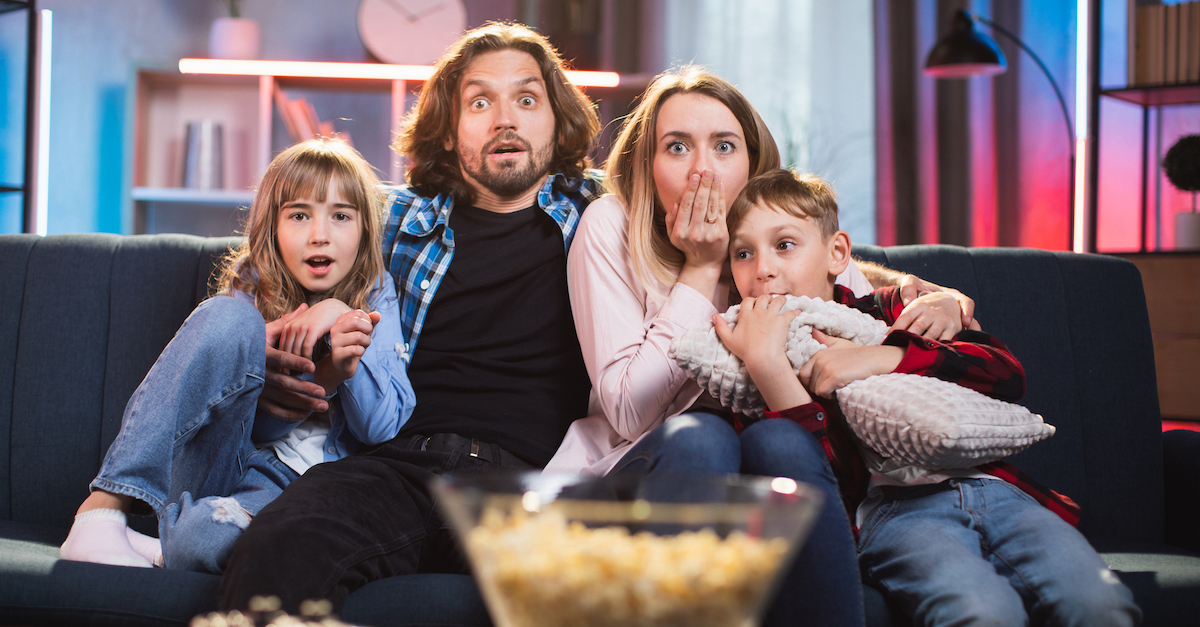A Parent’s Guide to Family-Friendly Films This Halloween
Movies


Audio By Carbonatix
5:20 AM on Tuesday, October 14
By Carrie Lowrance, Movies
When the Halloween season starts, there are horror movies everywhere. Streaming services and various channels play the classics, and there is always a plethora of new horror flicks at the theater. Sometimes the description of the movie isn't clear either, so it's hard to navigate what's a horror movie and what's not.
For example, years ago, my friend and I wanted to see a movie. I chose the movie Silent Hill because, from the description, it sounded like it had more of a psychological element than a horror element. I wound up walking out about half an hour in because it freaked me out so much. I am not a fan of horror movies at all.
So, how do you navigate movies for family viewing this Halloween? Here are some tips to help you stay on the family-friendly side of spooky.
Understanding the Spectrum: Horror vs. Family-Friendly Films
Horror films elicit feelings of fear, anxiety, dread, and terror. Elements often include suspense, gore, and the supernatural to spark these emotions. Themes include things like survival, the unknown, and morality. There are many sub-genres of horror as well, like psychological (the mental instability of a character), slasher (killer murders a group of people), supernatural (ghosts, monsters, otherworldly entities), and found footage (movie takes a documentary style approach).
Their accessibility and appeal to audiences of all ages characterize family-friendly films. Themes often focus on friendship, love, growth, adventure, and provide moral lessons and uplifting messages. Humor, heartwarming storytelling, and a touch of fantasy or whimsy help enhance the feel-good feelings.
Genres of family-friendly movies include:
Animated Features: Appeals to children with some layered humor for adults, like Toy Story.
Adventure Films: Focuses on adventure and companionship, like The Goonies.
Musicals: These combine storytelling and music, as seen in The Sound of Music.
The Impact of Scary Movies on Young Minds
Whether people believe it or not, scary movies have a profound impact on young minds. One of the primary psychological impacts is desensitization. Frequent exposure to horror movies can dull the senses of young viewers to frightening stimuli. As children and teenagers watch horror content, their threshold for fear increases, leading to a diminished response to real-life situations that should invoke fear. Desensitization can affect their emotional responses in critical situations, causing risks to their personal safety and interactions.
For some young viewers, horror movies can trigger fear and anxiety disorders. Horror movies depict extreme scenarios that can leave a lasting fear and anxiety in impressionable minds. These graphic depictions of violence, death, gore, and the supernatural can lead to nightmares and heightened anxiety levels, which can affect sleep patterns and daily functioning. If a child has existing anxiety disorders, these movies may exacerbate their symptoms, causing an unhealthy cycle of fear.
Sometimes horror movies can act as a coping mechanism for fear. Young kids often watch horror movies not only for entertainment but also to explore their fears in a controlled environment. Children learn to face their anxieties and reactions in a safe space, possibly enabling them to develop coping mechanisms that can carry over and be beneficial in real-life situations. This approach to confronting fear can cultivate resilience and emotional strength, as viewers learn to distinguish between fiction and reality.
Top 10 Family-Friendly Halloween Movies to Celebrate the Season
Here are ten family-friendly Halloween movies to watch this season.
It's the Great Pumpkin, Charlie Brown
Hotel Transylvania
Casper (1995)
The Addams Family (1991)
Hocus Pocus
Monsters, Inc.
Scared Shrekless
Ghostbusters (1984)
Toy Story of Terror
Addams Family Values
Although these are all family-friendly, you may want to double-check the rating for each movie to ensure it's suitable for your family.
Navigating Frightening Themes: Are They Appropriate for Children?

This is a complex issue that considers developmental psychology, context, cultural perspectives, and the purpose of fear in storytelling.
A child's ability to process fear changes significantly as they grow. Ages 0-6 perceive the world literally and struggle to differentiate between fantasy and reality. Frightening elements can contribute to immense distress.
By middle school, kids' cognitive abilities advance (ages 7-12), and they can grasp abstract concepts and understand metaphors and hyperboles. This makes it easier for them to engage in scary movies without becoming overly distressed. Still, the movie's context remains vital. A well-written story where characters overcome their fears can lead to resilience and emotional growth.
Teenagers often seek thrills and struggle with complex emotions. Frightening themes can resonate with their burgeoning identities and serve as a safe space for them to explore their fears and anxieties.
Cultural context also plays a significant role when determining the appropriateness of frightening themes for kids. Different cultures have distinct storytelling traditions that often incorporate elements of horror, myth, and cautionary tales. The old Brothers Grimm fairytales may not be appropriate for certain ages because of their dark tales that teach moral stories through fear. Compared to today's modern stories that don't have these elements in them, creating a safer narrative. What may be frightening to one culture may not be frightening to another. Therefore, parents need to guide kids through these themes in culturally appropriate ways.
Fear in storytelling can serve many purposes, including:
Facilitate emotional connection: Stories that embrace fear can help kids connect with their own emotions. They usually focus on characters facing challenges, which can lead to discussions about their feelings and fears.
Encourage problem-solving: Scary narratives sometimes put characters in perilous situations. When kids observe characters finding solutions to their problems, it inspires resilience in them.
Transcend boundaries: Engaging in fear can be thrilling and allows children to explore boundaries safely and experience high states of emotion without real danger.
Promote moral lessons: Some stories that use fear impart moral lessons. Some characters may encounter consequences for their actions, illustrating the importance of bravery, kindness, and wit.
Faith-Based Alternatives: Movies That Emphasize Hope and Courage
Some fantastic alternative movies that emphasize hope and courage are:
The Blind Side
A Week Away
The Girl Who Believed in Miracles
War Room
Letters to God
Veggie Tales (these TV shows and movies are perfect for little ones)
The Forge
The Star (2017)
Miracles From Heaven
The Lost Medallion: The Adventures of Billy Stone
I Can Only Imagine
Heaven Is For Real
These movies are for family viewing; however, double-check ratings depending on who is viewing the movie.
Parental Guidance: Rating Systems You Should Know

As we know, movie ratings change over time, so here is a clear idea of what each rating means.
Rated G: Anyone can watch, family-friendly
PG: Some material is not suitable for children.
Rated PG-13: Material is not appropriate for children under 13. These movies contain more intense violence, suggested themes, and brief nudity.
Rated R: Restricted to viewers 17 or older; includes intense sexual content, strong violence, and drug abuse.
NC-17 (No One Under 17 Admitted): Movies with this rating have sexual content that is inappropriate for minors.
TV Show Ratings:
TV-Y: All Children
TV-Y7: Directed toward older children
TV-G: Suitable for all audiences
TV-PG: Material not suitable for young children, parental discretion advised
TV-14: Parents strongly cautioned, not suitable for children under 14.
TV-MA: Tailored for adults only.
Knowing what each of these ratings means will help you make more informed viewing choices and have a general idea of what's in a show or movie, if your child is watching something they shouldn't be.
How to Discuss Fear with Your Kids After Watching
If you have just watched a show or movie with suspense and even a hint of spookiness, your children may still feel afraid. Here are some ways to discuss fear constructively.
Create a safe space for discussion: Choose a moment when everything is calm and there are no distractions, and gather your kids in a cozy area of your home. Let them know it's normal and okay to feel scared sometimes and that they can always talk about their feelings without judgment.
Listen actively: When your child opens up, listen actively. Give them your full attention, maintain eye contact, and encourage them with nods and affirmations. Let them express all their feelings before jumping to conclusions or offering solutions. Ask lots of open questions.
Validate their feelings: After they speak, discuss what they just watched. Once again, ask open-ended questions and then discuss the themes of the movie or show, encouraging your kids to think critically about the message conveyed.
Real vs. fictional fear: Help your child distinguish between real-life fears and fictional fears. Explain how some situations on TV and movies are exaggerated for effect and don't happen that way in real life. Talk about the characters' fictional fears and their own fears, helping demystify the fear and reassure them that there is no real danger.
Offer comfort and support: Give them a favorite stuffed toy or blanket for comfort. You can also teach them deep breathing and positive visualization techniques to help them cope. Another idea is to make a 'worry box' where they can write their fears and place them in the box to put them away temporarily.
Encourage them to share their fears: Let your kids know they can always come to you with their fears.
Reassure safety: Let your kids know they are always safe with you.
Evaluate movie and show choices together: Sit down and talk about each movie or TV show that you have picked and the various themes in them. Then you can decide as a family what's appropriate and what isn't.
Jesus is always there: Encourage your kids to always turn to Jesus when they are scared, and he will always be there for them, just like you are.
Creating a Halloween Movie Night Tradition: Tips for Families
Some tips for creating a Halloween night tradition are:
-Choose movies together.
-Plan on having the same 'spook' themed food and snacks.
-Get cozy with throw pillows, blankets, and pajamas.
-Relax and have fun.
Halloween doesn't have to be spooky; you can have lots of fun viewing the fun side of Halloween instead.
Related Articles:
Should Christians Watch Horror Movies?
6 Teen-Friendly Halloween Movies
7 New Family Films to Stream on Cozy October Nights
 Carrie Lowrance is a freelance writer and author. She has had her work featured on Crosswalk, iBelieve, Huffington Post, and the Penny Hoarder. She is also the author of three children’s books, three clean romance books, one romance novella, three books of poetry, and one non-fiction book. When she’s not writing, she enjoys cooking and baking, reading, and hanging out with her husband, and sweet cat, Cupcake. You can find out more about Carrie and her writing at www.carrielowrance.com.
Carrie Lowrance is a freelance writer and author. She has had her work featured on Crosswalk, iBelieve, Huffington Post, and the Penny Hoarder. She is also the author of three children’s books, three clean romance books, one romance novella, three books of poetry, and one non-fiction book. When she’s not writing, she enjoys cooking and baking, reading, and hanging out with her husband, and sweet cat, Cupcake. You can find out more about Carrie and her writing at www.carrielowrance.com.
